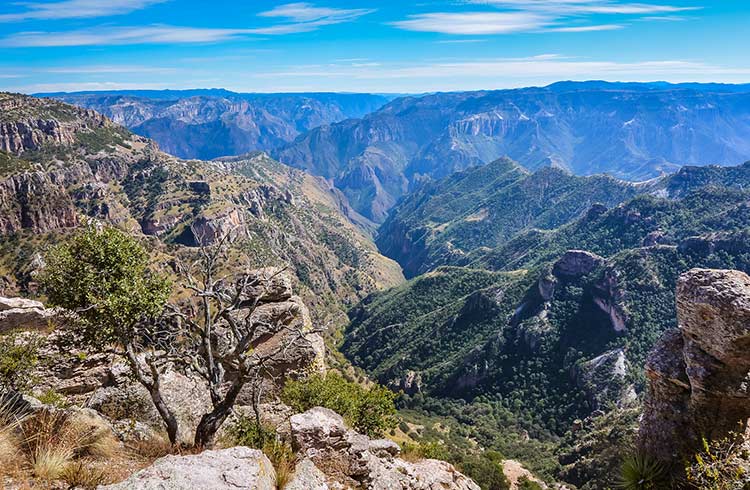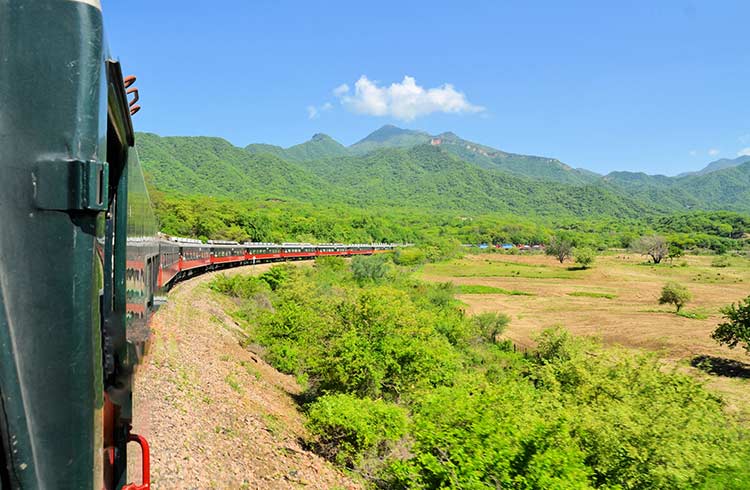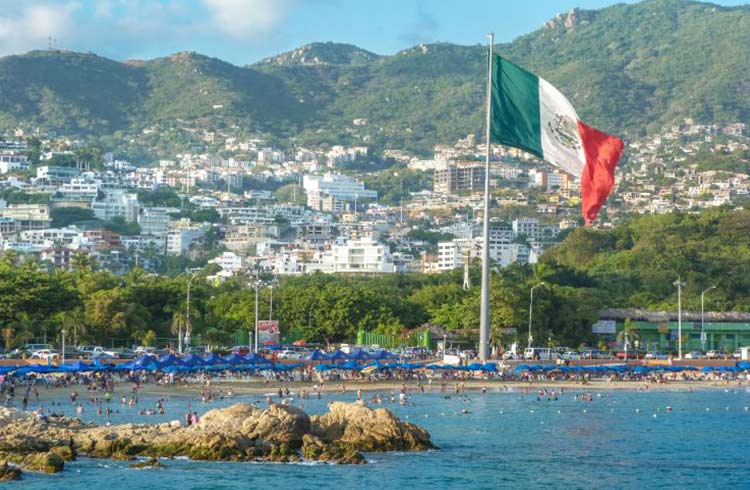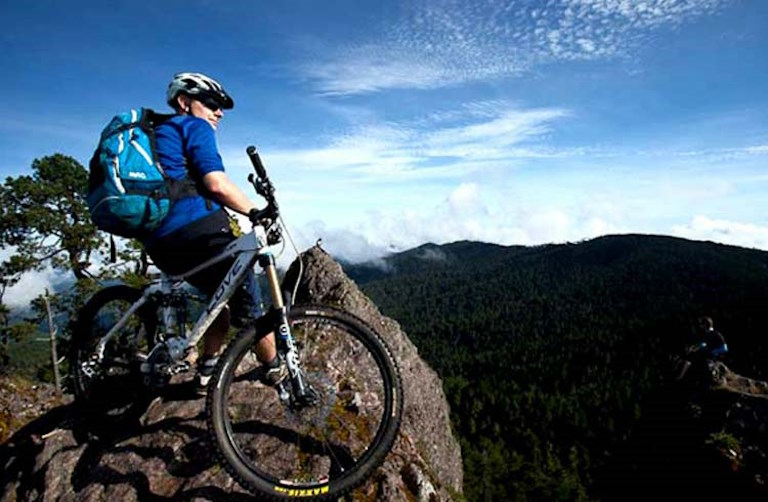An Adventure Traveler's Guide to Copper Canyon, Mexico
Here's what you need to know before visiting this spectacular series of canyons in northwestern Mexico. Get tips on hiking Copper Canyon, how to get there, taking the El Chepe train, and more.
 Photo © Getty Images/jejim
Photo © Getty Images/jejim
- Where is Copper Canyon?
- El Chepe, the Copper Canyon Train
- El Fuerte
- Bahuichivo
- Batopilas
- Divisadero
- Creel
- Basaseachi National Park
- Copper Canyon Adventure Park
- Hiking in Copper Canyon
- Mountain Biking in Copper Canyon
- Getting There, Getting Around, and Weather
Where is Copper Canyon?
A UNESCO World Heritage Site, Copper Canyon is located in the state of Chihuahua, Mexico. It's known for its spectacular landscapes and opportunities for outdoor adventure. Though some call it the "Grand Canyon of Mexico," Copper Canyon is actually a series of six separate canyons, which have a combined length that's four times bigger than its neighbor up north.
Riding El Chepe, the Copper Canyon Train
El Chepe (Ferrocarril Barrancas del Cobre) is the most popular way to get around Copper Canyon. The train runs 418mi (673km) from Chihuahua to Los Mochis, making many stops along the way. Make the most of your time in Copper Canyon by hopping on and off the train line, stopping to explore the small towns and incredible natural beauty.
Most travelers start in Los Mochis and travel west to east. For the best views along the way, sit on the right-hand side.
El Fuerte
El Fuerte will be the first stop if you've caught the train from Las Mochis. Stay a night or two in this authentic, colonial town to soak in the history while taking a few day trips. See the archaeological site of Cerro de la Mascara, where 300 petrolyphs have been found on rocks that were once used as a ceremonial center.
El Fuerte was founded on the banks of the Rio Grande, which winds its way to the Pacific Ocean. If you take a trip down to the river banks, come prepared with strong insect repellent, as bugs are an annoyance along the river.
Bahuichivo
Hop off the train in Bahuichivo for access to the Urique Canyon, one of the deepest in the region. The small community of Cerocahui is 9mi (16km) from the train station, where you'll find a number of budget hotels and campsites. If you've pre-booked accommodation, a car will be waiting for you at the station – there's also a daily bus between Cerocahui and Bahuichivo.
Take a one-hour hike to Cerocahuia Falls, or book a guided hiking tour in town to explore the Urique Canyon region.
Divisadero
The train will stop here for 15–20 minutes, so everyone on board has the opportunity to enjoy the views. Many travelers choose to spend a night or two here, and conquer a killer hike down into the canyon.
Accommodation is pricier here, especially if you opt for a room with a view on the rim of the canyon.
Creel
Sitting 7,350ft (2,240m) above sea level, Creel is another gateway town to Copper Canyon. While you're there, take the stairs from the corner of Gran Vision and Cristo Rey to the top of a hill where Escultura de Cristo Rey looks over the city. Take a day trip to the Recohuata Hot Springs, just 13mi (22km) from Creel. To get there, take a taxi, go by horseback, hire a bike, or hike to the base of Tararecua Canyon.
Creel is home to the Indigenous Tarahumara, and many tours to see nearby sites such as Valle de los Hongos and Valle de las Ranas will include visits to the caves where some families live.
Batopilas
A long, hair-raising, five- to six-hour bus from Creel to Batopilas will be well worth it. Deep in the canyon on the banks of the Batopilas River, the Indigenous Raramuri community bring this place to life, wearing traditional, colorful clothing as they roam the streets lined with colonial buildings. Be warned: the bus journey is not for the faint hearted, so come prepared with motion-sickness tablets.
Basaseachi National Park
Take a three-hour drive from Creel to Basaseachic Falls National Park in Candameña Canyon, home to Basaseachic Falls – the second-tallest waterfall in Mexico, dropping a whopping 812ft (246m). You can see it from various lookouts along hiking trails through the park.

Barrancas del Cobre Adventure Park
Locaded just 1mi (1.5km) from the El Chepe Posada Barrancas train station, the Adventure Park has five main attractions: a via ferrata, an aerial tram, a circuit of seven zip lines, a canopy walk, and the ZipRider – one of the longest ziplines in the world, reaching terrifying speeds of up to 84mph (135km/h).
Take in the sights of the canyon as you hang from the 1,476ft (450m) high, 8,379ft (2,554m) long zipline. If you take a tandem zip with a guide, you won't need to control your speed or worry about crashing into the platform.
The Via Ferrata is more comparable to an adventure assault course. Abseil your way down the canyon wall, walk over suspension bridges, and cross wires above the canyon.
The Aerial Tram is one of the most impressive cable cars in the world, with a length of 1.69mi (2.73km). After the adrenaline rush of zip-lining, make your way back via the cable car to soak in the views at a slower pace.
Hiking in Copper Canyon
For safety reasons, it's advised to hike Copper Canyon with a trusted local guide, especially if venturing off the beaten path, as trails aren't well marked, and maps aren't very accurate. The terrain is extreme throughout the system of canyons. In the past, travelers have fallen and injured themselves. To help prevent accidents, wear appropriate hiking gear, and pack a wet weather jacket and fleece just in case the temperatures drop in the evening. Always take enough water and food with you to keep your energy levels high.
One deservedly famous hike is the three- to four-day, 32mi (52km) hike from Cusarare to Divisadero. Trailheads can be accessed by public transport from Creel. Along the way, admire Cusarare Falls and take a swim in the Rio San Ignacio.
The most popular hike is from Batopilas to Urique, a 32mi (52km) trail that'll take three days. Start the hike in Batopilas, and catch a bus from Creel to get there.
Mountain biking in Copper Canyon
The town of Creel is the gateway to Mexico's thriving mountain and road biking scene. Each year in July, the town hosts a major national cycling event and race series.
At an elevation of 2,342m (7,683ft), just about every kind of trail can be accessed: world-class technical single-track, forest roads, Moab-quality slick rock, rocky desert landscape, challenging long climbs and descents on old mining tracks, and winding back roads.
This mountain biking mecca certainly isn't for newbies – although there are clear tracks to follow, a guide is still recommended. You'll no doubt meet some obstacles along the way, anything from rock slides to a donkey. Come prepared with repair kits and spare tires.
Trip notes
Getting there
Fly: Travelers can fly into Chihuahua or Los Mochis. Chihuahua has a much larger airport than Los Mochis. but both offer a few international flights from southern states in the US as well as domestic flights.
Driving safety: If you're taking a road trip, be cautious when driving through border regions, and avoid stopping in Ciudad Juarez. Be sure to check road conditions ahead of time and look into recent events and/or government warnings. Parts of Mexico can be very dangerous so it's best to know exactly where you are going and what areas to avoid.
Getting around
Train: There are two types of El Chepe train — the Chepe Express and Chepe Regional. The Express is faster and more comfortable, with three classes (First, Executive, Tourist). The Regional is slower, stops at more stations (around 13), and runs with Tourist and Economy options. Advance booking is strongly recommended, especially for the Express.
Bus: There are buses available in Chihuahua and Los Mochis, although Chihuahua will have more services on offer. Buses also connect Creel and Chihuahuha, Ciudad Juarez and San Raphael – the route to take if you want to hop off at Divisidero.
Taxi: Taxis are available at Los Mochis and Chihuahua airports, but they don't use a meter (agree on a fare before setting off), and only use registered taxis. Inside Copper Canyon, you're not likely to find any taxis.
When to visit
Spring in Copper Canyon (February–June) is when the weather is generally dry, but beware this is windy season and adventure activities could be cancelled.
Rainy season falls during summer (July-September), but despite the rain, this is a beautiful time to visit, when waterfalls are at their peak and plants are vibrant green. Expect extremely hot and humid conditions, and carry insect repellent to keep the mosquitoes at bay.
Autumn (September–October) is the most pleasant time to visit Copper Canyon, when it's generally warm throughout the region, but weather extremes aren't an issue. Bear in mind that spring and autumn are the busiest times at the canyon.
Winter (November–January) can be fairly cold, so layers are recommended. There is also the risk of some transportation being cancelled due to ice and snow. With some research and careful planning, there is no reason why you can't still enjoy a trip in the Copper Canyon during the winter months.
Related articles
Simple and flexible travel insurance
You can buy at home or while traveling, and claim online from anywhere in the world. With 150+ adventure activities covered and 24/7 emergency assistance.
Get a quote


No Comments